HJ Service Cap (with red piping)
CATEGORY: Version
SKU: 31.GOR.01.01.02.001.000
Estimated market value:
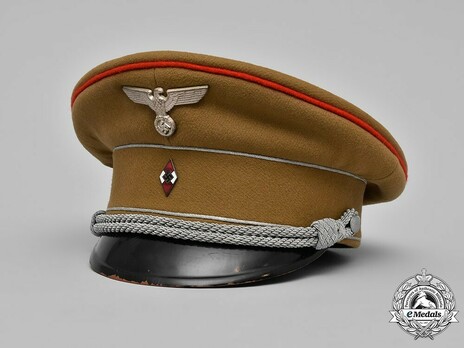
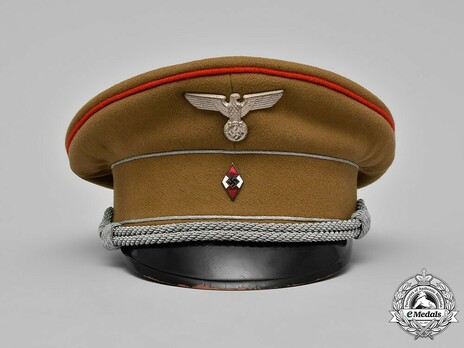
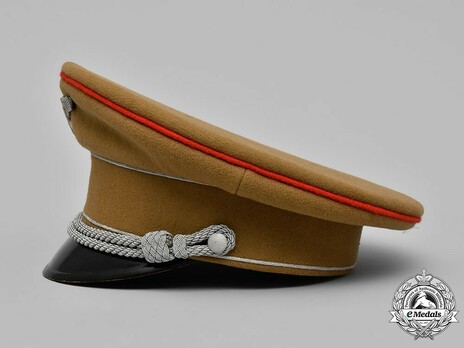
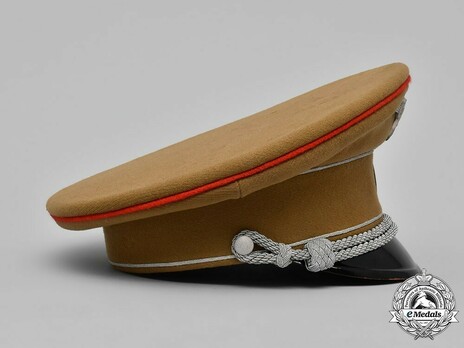
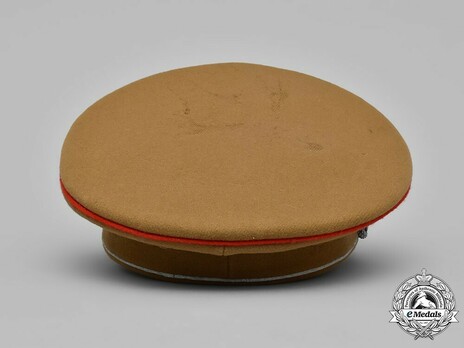
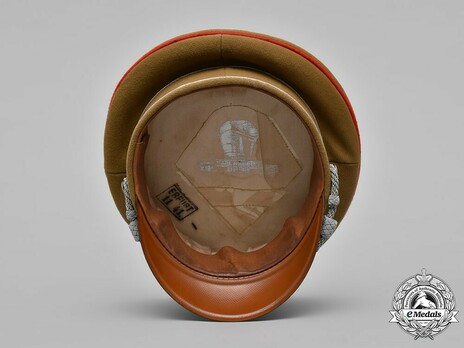
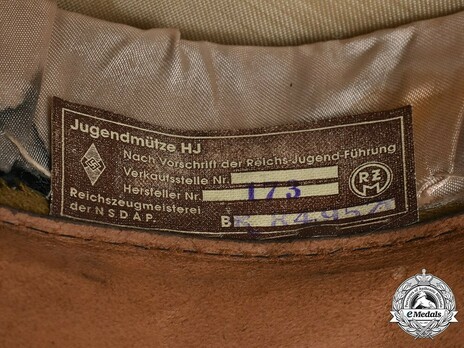
Estimated market value:
Constructed of light brown doeskin wool. The crown of the cap is fully trimmed with a band of red piping, while the cap band is trimmed at both the top and bottom with bands of silver aluminum piping. Pinned into the peak of the cap is a silvered zink NSDAP-style German national eagle clutching a wreathed mobile swastika. The eagle retains all three reverse attachment prongs and measures 62 mm (w) x 32 mm (h). Pinned into the cap band underneath the eagle is an HJ insignia, constructed of silvered bronze with multi-coloured enamels, consisting of a black mobile swastika on a red and white checkered diamond. The insignia measures 14 mm (w) x 25 mm (h). The cap is flanked on each side by a pebbled magnetic metal button holding in place a decorative chinstrap, itself constructed of multiple rows of silver aluminum wire with slidable knots at each end. The chinstrap rests upon the visor, which is constructed of vulcanfibre and presents with a lacquered black obverse and light brown reverse. The interior features a 40 mm-wide brown leather sweatband securely held in place by a row of machine stitching. There is a complete off-white rayon liner, the crown of which formerly had a transparent moisture guard, with a silver maker’s mark reading “KARL NAUBERT, ERFURT”. The crown is also stamped with “ERFURT 11 41”. A Reichszeugmeisterei (RZM) tag is located underneath the sweatband, clearly bearing a manufacturer code of “173” and serial number of “B84957”. The cap measures approximately 245 mm (w) x 265 mm (l) x 148 mm (h). Moderate material fatigue is evident to the exterior, there is some soiling of the interior, and the moisture guard has mostly disintegrated. The cap is in an otherwise better than very fine condition.
On September 8, 1933, the regulations for the Service Cap were introduced. The basic form of this cap was primarily worn by all members of the HJ. The Hitlerjunge ranks wore the HJ enamel diamond in the center of the peak, while the Kameradschaftsführer ranks and above wore it just above the cap band, with the (1st pattern) national emblem on the peak. According to the September 30, 1938 regulations, the large (2nd pattern) national emblem was introduced to accompany the enamelled HJ diamond.
As of April 30th, 1937, the Service Cap was worn with the Kleiner HJ-Dienstanzug (HJ informal service dress), as opposed to the Summer Cap, which was worn with the Großer HJ-Dienstanzug (HJ formal service dress).
The visor was khaki for Unterbannführer rank and below, or black for Bannführer rank and above. In the same manner, the chin strap was brown and had brown buttons for the lower ranks, and black with black buttons for the higher ranks. This regulation was changed on November 6, 1936, wherein the brown cloth visor was forbidden, and starting in 1937, had to be replaced by a black leather visor. The same was true for the brown chin straps and buttons, which were replace with black ones.
The cap featured a 2.5mm wide piping, either in the colours of the HJ subdivision (i.e. Motor-HJ, Flieger-HJ etc.) or in the Oberbann colour. Initially there were five Oberbanne (regional divisions). The colours were red for Oberbann 1, yellow for Oberbann 2, green for Oberbann 3, blue for Oberbann 4, and black for Oberbann 5. These colours were worn by the ranks of Hitlerjunge to Bannführer, but in contrast to the ranks below, Bannführer had a white cap band instead of a khaki one. Oberbannführer wore a yellow cap band and Gebietsführer wore a red one, but both had silver-coloured piping. Obergebietsführer and Stabsführer wore a light red cap band and gold-coloured piping. Bannführer (Staff) wore a carmine cap band with white piping, Oberbannführer (Staff) and Gebietsführer (Staff) had a carmine cap band with silver-coloured piping, and Obergebietsführer (Staff) wore a carmine cap band with gold-coloured piping. Senior leaders of the Reichsjugendführung Staff wore a light red cap band with gold-coloured piping.
From February 9th, 1936-1937, the Leaders’ caps were issued with three bands of aluminum piping: at the top and bottom of the cap band and about the edge of the top. By September 30th, 1938, this was design was altered, placing branch piping around the top, and aluminum piping at top and bottom of a velvet cap band, as well as having an aluminum chin strap and a black lacquered visor. Further changes were made in 1939, including the addition of a black vulcan fiber hardened visor, the use of a large (2nd pattern) silver-coloured national emblem (3rd pattern was introduced at some time during the war), and the use of and enamelled HJ diamond.
Ranks from Gefolgschaftsführer to Hauptgefolgschaftsführer were given light brown cap bands, silver-coloured buttons, a silver-coloured cord chin strap, and the piping was commonly in red or silver colour, but branch colours were also used. The ranks of Stammführer and above got black velvet cap bands, while Stammführer to Hauptbahnnführer also had silver-coloured buttons and silver-coloured cord chin straps, but silver-coloured piping. Gebietsführer to Stabsführer ranks had gold-coloured buttons, a gold-coloured cord chin strap, and gold-coloured piping. This also applied to the corresponding leader ranks of the German Youngsters.
In addition to the six piping colours of the subdivisions of the HJ – added on April 30, 1937, and April 9, 1938 respectively (see Summer Field Cap / Sommer-Feldmütze for details) – carmine piping was added to the caps of HJ members with specialized training at the Gebiets- und RJF-Stäbe (District Staff Headquarters and Reich Youth Leader Staff Headquarters), as well as light blue piping for the Feldscher-HJ (Medical) subdivision.

Comments
Sign in to comment and reply.


Scroll Top